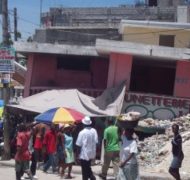Life Around the Rubble
Blog / Produced by The High Calling
My recent trip to Haiti rocked me in ways I never expected. Being exposed to that level of poverty is gut-wrenching enough, but add to it the destruction from January’s earthquake and the experience becomes rather difficult to put into words. While I saw lots of reasons to believe that healing will come, on the surface the circumstances there still seem desperately hopeless.
Large piles of concrete rubble lie stacked on the roads at every turn, reminding me of meager attempts to clean up. There are exposed foundations with new sections of block walls reaching upward, but re-construction has continued almost unnoticeably since many either cannot access or cannot afford the materials they need.
And the buildings that still stand bear the scars of the tragic earthquake. As potentially unstable as they are, their cracked and damaged walls provide a much needed shelter to many who have no place to go.
Everywhere I looked there was work to be done and I found it easy to question why more wasn't under way: Why aren’t more people rebuilding? Don’t they care that everything is still in shambles?
But as I watched, I observed that practically every street was lined with vendors selling food, water, clothing, household goods, or whatever products they could get their hands on. There's no Super Target here. If you need a tube of toothpaste, you walk down the street until you find the lady who sells it.
I applaud the resilience of the people of Haiti. After all, they still need to eat and care for their families, which means they still need to make money.
Dealing with rubble
What I worry about is the long-term physical, emotional, and spiritual impact of simply working around the rubble. Every day they walk around and over piles from the earthquake and its aftershocks in order to go about their business. It's become part of the landscape that they navigate in order to make life happen.
But some things have to be dealt with in order to find healing, right? It may seem easier and like it’s all that can be done to stack the rocks off to the side, but that pile still needs to find a permanent home. Moving it for good would mean confronting the very thing that brought so much fear, pain and sadness. While it may force them to confront those feelings directly, I think it’s important to get it done so that they can move on.
And yet, I have my own piles of rubble that I walk around and over. I can’t imagine how hard it must be to deal with the physical ones, too.
Creative idea
The orphanage where we stayed had a large pile of rubble. Our team used it creatively in several projects that helped to provide a nicer place for the orphans to live, work, and play. We couldn't use the entire pile, but what was once a towering reminder of a horrible tragedy became something that made people smile.
It's going to take a long time to clean up and build up. And few piles will go away as easily as the one at the orphanage, but I have great hope for the people. I can see the freedom they will experience as they move without hindrance in a space that once bore the witness of so much death and destruction.
Photo and post by Dan King.




